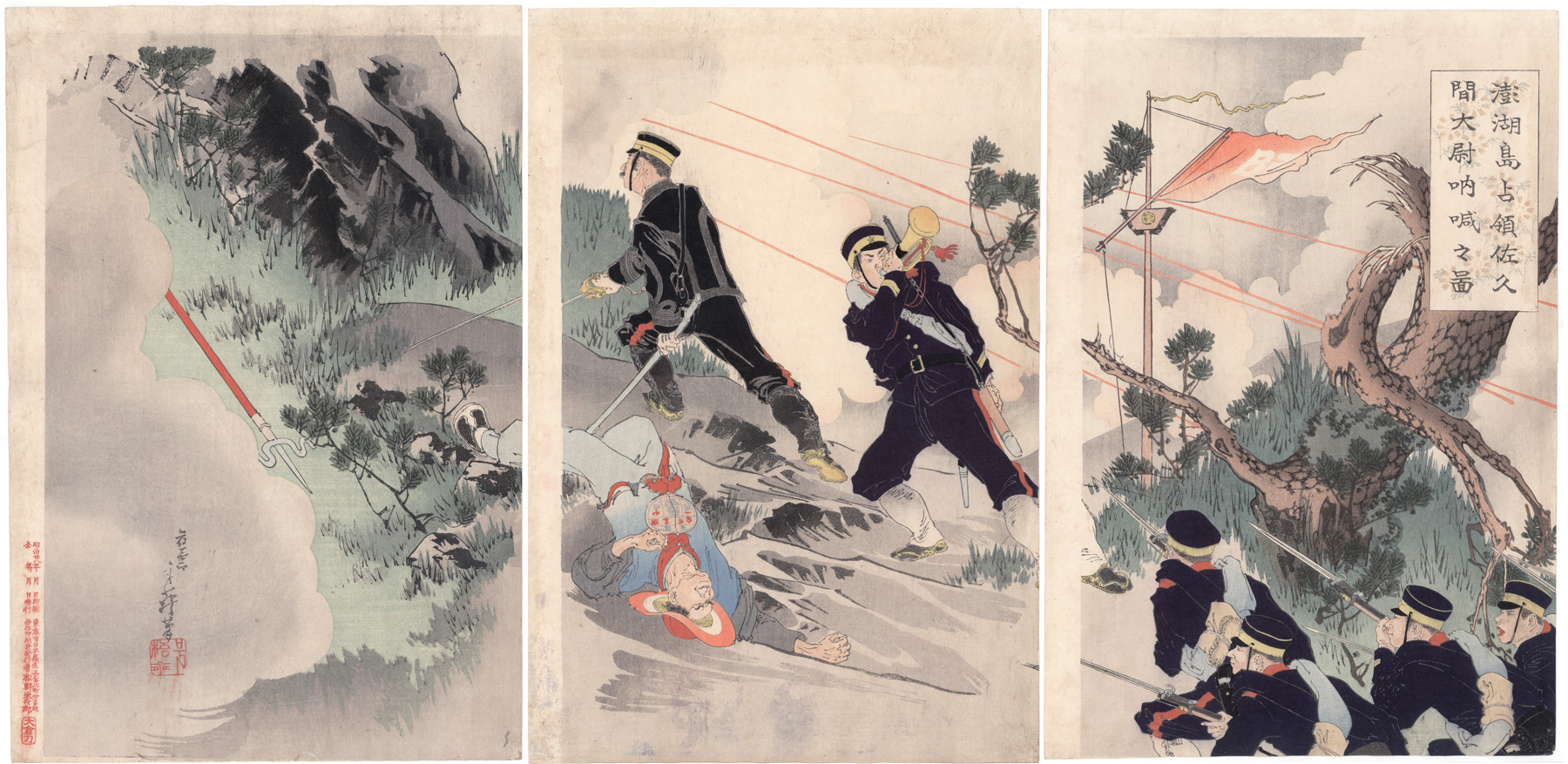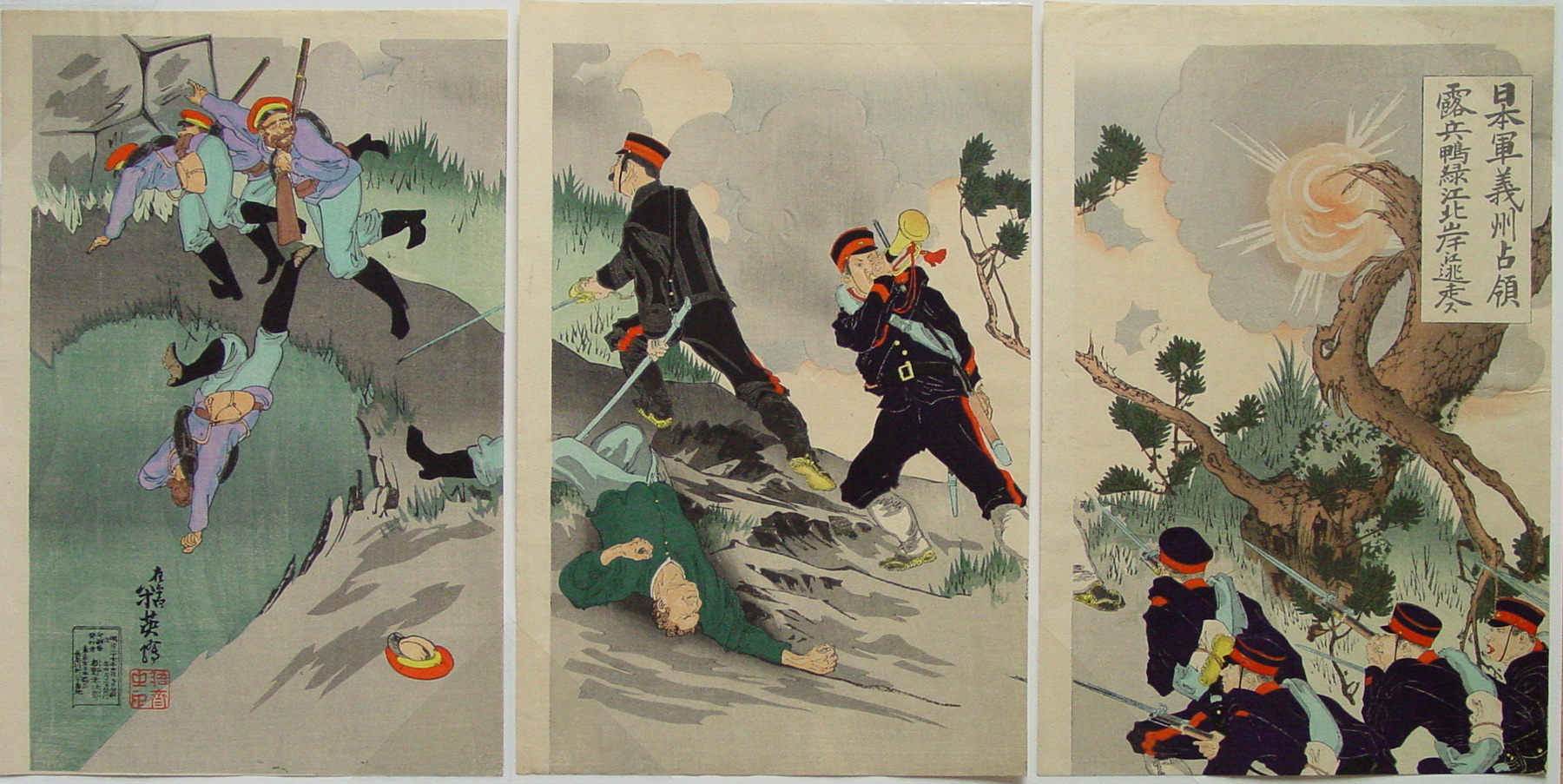About This Print
The Brave Captain Sakuma
| One of many prints, by this artist (see Captain Matsuzaki Fights Bravely in the Battle of Songhwan) and other artists, that glorified the actions of particular officers or soldiers whose tales of valor were recorded by the press. In this print we see Captain Sakuma leading a bayonet-charge of his Fourth Company coming to the aid of the Japanese First and Second Companies during the afternoon of March 23, 1895.1 Captain Sakuma's Fourth Company, along with the First, Second and Third Companies, had been set ashore earlier in the afternoon from a detachment of transports anchored in the bay of Li-chon-chiao to capture the Kon-peh-tai fort on Pa-chau Island (modern-day Wang-an.)2 As the artist was not present at the battle, he constructed this scene largely from his imagination, as did almost all the artists who portrayed the war. |
Battle of the Pescadores
Source: Wikipedia https://en.wikipedia.org/wiki/Pescadores_Campaign_%281895%29Re-using This Design
Nine years after this print was published, the publisher Matsuno Yonejirō reused the design to depict an engagement during the Russo-Japanese War (1904-1905.) For commentary on reuse of print designs depicting the Sino-Japanese War to depict scenes from the Russo-Japanese War see the section titled "Unabashed Plagiarism" on the page for the print titled Japanese Forces Occupying Yizhou. Russian Soldiers Fleeing to the North Bank of the Yalu.
| Migita Toshihide, 1895 Captain Sakuma Raising a War Cry at the Occupation of the Pescadores | Yonehide, 1904 Japanese Forces Occupying Yizhou. Russian Soldiers Fleeing to the North Bank of the Yalu |
1 Heroic Japan: A History of the War Betwen China & Japan, F. Warrington Eastlake and Yamada Yoshi-aki, Sampson Low, Marston & Company, 1897, p. 401-403.
2 [The] Island of Formosa, Past and Present. History, People, Resources, and Commercial Prospects, James Wheeler Davidson, Macmillan & Co., 1903, p. 266-267.
Print Details
Print Details
| IHL Catalog | #1221 |
| Title or Description | Captain Sakuma Raising a War Cry at the Occupation of the Pescadores 澎湖島占領佐久間大尉吶喊之図 Hōkōtō senryō Sakuma taii totsukan no zu |
| Artist | Migata Toshihide (1863-1925) |
| Signature |  |
| Seal | Ban? Gōsai ? 梧斎 (shown above below signature) |
| Publication Date |  |
| Publisher |  |
| Carver |  |
| Impression | excellent |
| Colors | excellent |
| Condition | good - full size (except left sheet which is irregularly trimmed - see Paper dimensions below); light backing; separate sheets; light soiling and toning; several wormholes covered by backing sheet |
| Genre | ukiyo-e; senso-e (Sino-Japanese War) |
| Miscellaneous | |
| Format | vertical oban triptych |
| H x W Paper | right sheet: 14 3/4 x 9 15/16 in. (37.5 x 25.2 cm) center sheet: 14 3/4 x 10 1/16 in. (37.5 x 25.6 cm) left sheet top: 14 13/16 x 10 1/16 in. (37.6 x 25.6 cm) left sheet bottom: 14 13/16 x 9 11/16 in. (37.6 x 25.6 cm) |
| H x W Image | right sheet: 14 3/16 x 9 1/4 in. (36 x 23.5 cm) center sheet: 14 1/8 x 9 1/4 in. (35.9 x 23.5 cm) left sheet top: 14 1/8 x 9 1/4 in. (35.9 x 23.5 cm) |
| Literature | Massacres in Manchuria, Sino-Japanese Prints 1894-1895, Ukiyo-e Master Series,: Vol. 13, ed. Jack Hunter, Shinbaku Books, 2014, p. 124. |
| Collections This Print | Museum of Fine Arts, Boston 2000.134a-c, 2000.205a-c; Princeton University Art Museum 2008-130 a-c |





